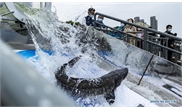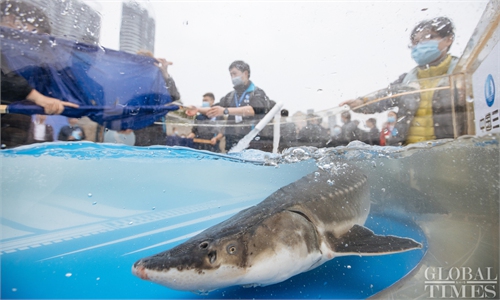China cracks down on poaching of endangered ‘living fossil’

Photo taken on April 22, 2020 shows the release of the Chinese sturgeons to the Yangtze River in Yichang, central China's Hubei Province. About 10,000 second filial generation Chinese sturgeons were released into the Yangtze River on Wednesday to increase wild stocks of the rare species.Photo:Xinhua
Over the past three months, police in China have detained two men for poaching Chinese sturgeons. The move reflects that the country is drawing a line in the sand when it comes to conservation of the endangered species.
The man, surnamed Qi, recently caught a wild Chinese sturgeon in Nanling, East China's Anhui Province. He came to the attention of the authorities after he posted a photo of his catch on social media.
It is estimated that the sturgeon was worth 50,000 yuan ($7,700) and Qi has been detained by the local police for further investigation, according to a report from Beijing Youth Daily on Monday.
In June, a fisherman surnamed Li was also put on trial in East China's Jiangsu Province on charges of harming endangered wild animals.
Li was sentenced to a year and four months in prison for catching and later cooking and eating a wild Chinese sturgeon.
The Chinese sturgeon lives in the fresh waters of the Yangtze River as well as marine waters off the coast of China. The earliest fossils of the animal date back to the Cretaceous period millions of years ago.
Experts became aware that it was nearing extinction toward the end of the 20th century as its numbers were growing lower year after year due to human destruction of its habitat.
The country completely banned the commercial fishing of Chinese sturgeon in 1983, and later in 1989 listed it as a first-class protected animal.
"In fact, the annual natural spawning season no longer takes place among wild Chinese sturgeons," Chang Yukang, vice minister of China's Agriculture and Rural Affairs, told the Science and Technology Daily in 2018, explaining that over the past few decades the species has only seen "occasional spawning."
To promote the natural repopulation of the Chinese sturgeon, China has released more than 70 million sturgeon bred in captivity into the wild 64 times over the past three decades.
However, the results of the program have had little visible effect according to experts. Since 2017 to 2020, "the green bean-sized fish eggs have not been detected in the river waters," Wei Qiwei, a researcher at the Chinese Academy of Fishery Sciences, told the Beijing Youth Daily in May.
"It's a shame that these men caught those living fossils," one netizen posted on Chinese social media.
"They are creatures that lived in the same era as the dinosaurs."
Global Times



